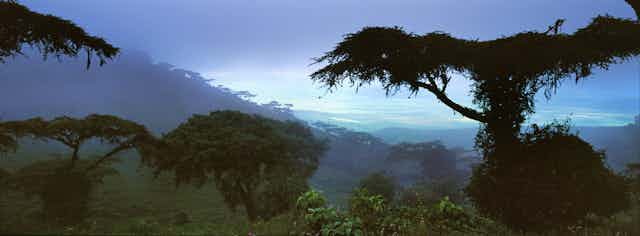Large trees are the living, breathing giants that tower over tropical forests, providing habitat and food for countless animals, insects and other plants. Could these giants also be the key to slowing climate change?
The Earth’s climate is changing rapidly due to the buildup of greenhouse gases, like carbon dioxide, in the atmosphere as a result of human activities. Trees absorb carbon from the air and store it in their trunks, branches, and roots. In general, the larger the tree, the more carbon it stores.
Globally, tropical forests remove a staggering 15% of carbon dioxide emissions that humans produce. Africa’s tropical forests – the second largest block of rainforest in the world – have a large role to play in slowing climate change.
But large trees are in trouble everywhere. I carried out research to examine the distribution, drivers and threats to large trees in Gabon. Gabon has 87% forest cover and is the second most forested country in the world.
By carrying out this project, I was able to identify areas with a wealth of large trees (and therefore key carbon stores and sinks), what needed to be done to better protect them and eventually recommend those areas as a priority for conservation.
National inventory
In 2012, the government of Gabon began a national inventory of its forests to measure the amount of carbon stored in its trees – one of the first nationwide efforts in the tropics.
An inventory of this scale isn’t easy, especially in a heavily forested country. Technicians from Gabon’s National Parks Agency travelled to every corner of the country, sometimes hiking more than two days crossing swamps and traversing rivers, to measure the diameter and height of trees in plots a bit larger in size than a soccer field.
Using Gabon’s new inventory of 104 plots, we calculated the amount of carbon in 67,466 trees, representing at least 578 different species. We did this by applying equations to the tree measurements.
The results indicated that the density of carbon stored in Gabon’s trees is among the highest in the world. On average, Gabon’s old growth forests harbour more carbon per area than old growth forests in Amazonia and Asia.
Most of this carbon is stored in the largest trees – those with diameters bigger than 70cm at 1.3 meters from the ground. Just the largest 5% of trees stored 50% of the forest carbon. In other words, 3,373 trees out of the 67,466 measured trees contained half of the carbon.
Drivers of forest carbon stocks
Next, we examined the drivers of carbon stocks. What determines whether an area of forest holds many large trees and lots of carbon? Do environmental conditions or human activities have the largest impact on forest carbon stocks?
Environmental factors – such as soil fertility and depth, temperature, precipitation, slope and elevation – often influence the amount of carbon in a forest. During photosynthesis, trees harness energy from the sun to convert water, carbon dioxide, and minerals into carbohydrates for growth. Therefore, forests with low levels of soil minerals or that receive little rainfall should store less carbon than areas with abundant minerals and water.
Human activities – like agriculture and logging – also influence carbon stocks. Cutting down trees for timber, to clear land for farming, or for construction reduces the amount of carbon stored in forests.
We examined the amount of carbon in each tree plot in relation to the environmental factors and human activities associated with the plot. Surprisingly, we found that human activities, not environmental factors, overwhelmingly affect carbon stocks.
The impact of human activities on forest carbon was largely unexpected because of Gabon’s high forest cover (the second highest of any country) and low population density (9 people per square kilometer), 87% of which is located in urban areas. If human impacts are this strong in Gabon, what must their effects be in other tropical nations?
Although we don’t know for sure, we believe past and present swidden (slash-and-burn) agriculture is the principle cause for low carbon stocks in some areas. Forests close to villages had lower levels of carbon, probably because forest clearing for farming converts old growth forest to secondary forest.
Interestingly, forests in logging concessions held similar amounts of carbon as old growth forests. It is too early to conclude that timber harvest doesn’t reduce carbon levels by cutting large trees, but this finding gives hope that logging concessions can be managed sustainably to conserve carbon stocks.
Importantly, forests in national parks stored roughly 25% more carbon than forests outside of parks. Thus, protecting mostly undisturbed forests can effectively conserve carbon and biodiversity.
Saving Gabon’s giants
The critical role of humans in diminishing carbon stocks is both a blessing and a curse. One one hand, the future of forests are in our hands, giving us the power to choose our fate. On the other hand, we cannot ignore the responsibility to act collectively to secure these resources while considering the interests of the countries that host them.
Gabon is taking laudable actions to conserve its forests, including a protected area network of 13 parks. In addition, Gabon is reforming its logging sector and developing a nationwide land use plan. These actions are a great start, yet continued action is necessary to curb the effects of swidden agriculture and ensure that growing industrial agriculture does not reverse Gabon’s achievements.
Intact forests can pay returns. Norway recently committed to paying Gabon $150 million for stewardship of its forests. Conservation of forests requires sacrifice by the Gabonese people. Yet, this payment demonstrates that Gabon’s large trees are a national asset that can contribute to its development as well as an international resource requiring collective action to conserve.

